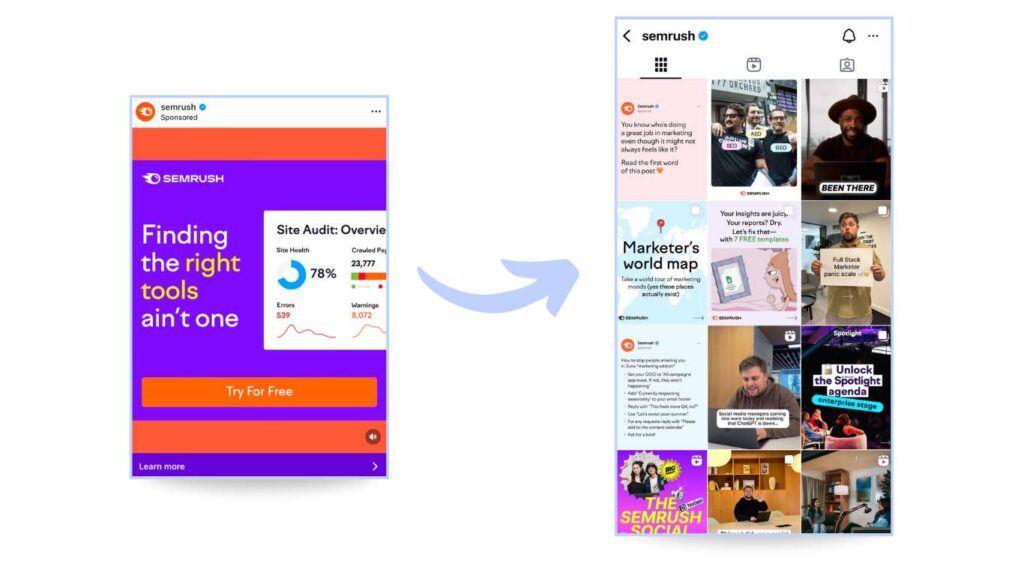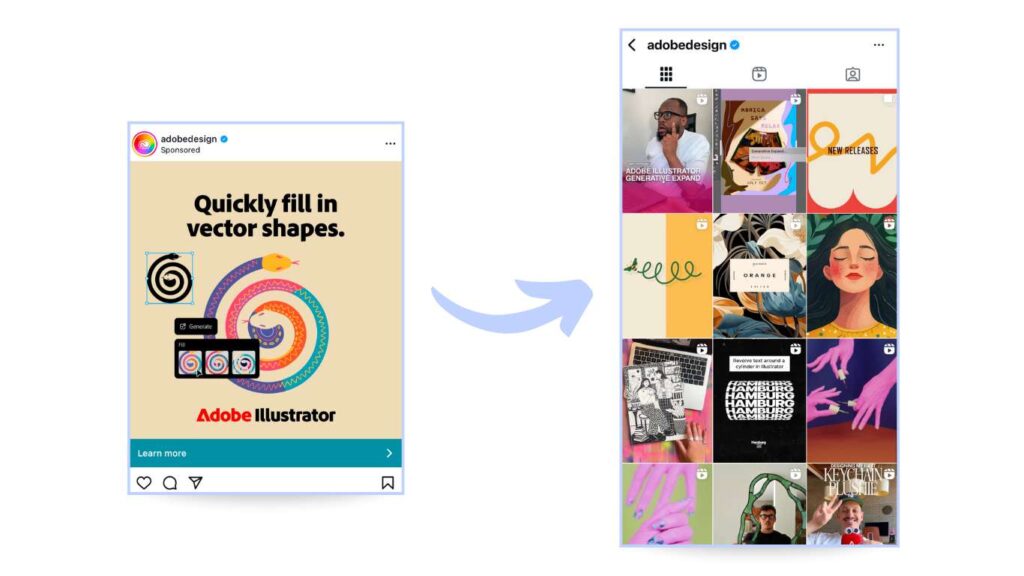📝 TL;DR: organic vs. paid social media
Paid ads get you seen. But organic content makes people stay.
Here’s why relying on ads alone won’t cut it anymore:
– First impressions happen on your feed, not in your ad.
Users click your profile before they click “Buy.” A quiet or outdated feed impacts trust
– 78% of consumers say a brand’s social presence influences their trust.
For Gen Z, it’s even 88%. And that trust doesn’t come from sponsored posts but from what you publish organically.
– Organic content is what keeps your funnel alive.
Yes, ads drive traffic but without strong organic content, you’re just renting attention.
TL;DR of the TL;DR?
If your feed’s not working, your ads are wasting budget.
Organic vs. paid social media: Key definitions
Before we talk strategy, let’s get one thing straight: content marketing and paid social ads are not the same thing (shocker).
They play different roles, follow different rules and speak to your audience in totally different ways
Social media content marketing (organic)
Content Marketing is often defined as “creating and distributing valuable, relevant content to attract and retain a clearly defined audience.” On social media, that means posts that earn attention by being useful, entertaining, or just refreshingly human. Instead of pushing messages, you’re building a presence people actually want in their feed.
Here are some examples of organic social media content:
- YouTube: A behind-the-scenes vlog showing how your product is made.
- Instagram: A carousel post with quick tips or relatable memes your audience wants to share.
- LinkedIn: A founder story or expert POV post that kicks off real conversations in the comments.
- TikTok: A short, unfiltered how-to clip that actually solves a problem (and maybe makes people laugh).
While technically organic content is free to publish, it still requires a lot of dedication and resources like time and a well thought-out strategy.
Social ads (paid)
Paid Social Ads are promotional units that brands pay to place on social platforms, typically to reach specific audiences quickly and at scale. Instead of waiting to earn attention, you’re buying access to it. The main advantage? Precision targeting, speed, and guaranteed visibility.
Here are some examples of common paid placements:
- Instagram: Sponsored posts in the feed, Reels ads, Stories placements or ads shown on the Explore page.
- TikTok: In-feed ads, TopView (the full-screen ad when you open the app) or Spark Ads that boost organic posts.
- YouTube: Pre-roll video ads, mid-roll breaks or display cards placed during videos.
- LinkedIn: Sponsored posts, message ads and sidebar display formats targeting by job title, industry, or seniority.
While paid ads give you fast reach, they also come with their own resource demands—like budget allocation, media buying skills, campaign testing, and constant performance optimization.
💡 Bottom line: Content builds trust. Ads buy attention.
Organic vs. paid social media: key differences
| Aspect | Organic Social Content Marketing | Paid Social Media Advertising |
| Trust signal | social proof (especially with engaging comment section) | Lower, perceived as promotion |
| Cost | Free to post (time & creative cost only) | Requires a monetary budget |
| Speed of results | Gradual growth over time | Immediate visibility and faster results |
| Longevity | Content can have long-term engagement and shelf-life | Ad stops delivering once the budget is spent |
| Audience building | Can be used to build a community and loyal followers organically | Mainly focused on short-term actions like conversions or traffic |
| Targeting precision | Limited to content strategy | Highly customizable targeting by demographics, interests, and behaviors |
| Purpose & use case | Ideal for storytelling, brand building, and community engagement | Ideal for promotions, lead generation, product launches, and sales-driving |
Why organic content is more important than you might think
It’s easy to think of organic content as the “nice to have” next to performance-driven ads. But that logic doesn’t hold anymore. In reality, your organic presence is doing the heavy lifting after the click—when potential customers land on your profile, looking for signals they can trust. And if that layer is missing, paid alone won’t save you.
Trust & social proof
According to the Digital 2025 Global Overview Report, over 50% of adult social media users worldwide look up brands on social platforms to learn more. In Austria, it’s 41.3%. In the US, 40.7%. What happens next depends on what they see.
A quiet feed, no replies to comments and outdated posts send one clear message: not active, not relevant. On the flip side, a brand that
- responds to comments,
- posts relevant content consistently
- AND sounds like a real person
builds trust.
In short: If your profile looks alive, your brand feels trustworthy.
Algorithm shifts
Yes, organic reach might not be what it used to be, but that doesn’t mean it’s gone. Today’s algorithms reward consistency, relevance and engagement.
For brands, that means one thing: show up often, or risk disappearing from the feed entirely. Frequency signals credibility, both to platforms and to your audience.
Bounce & conversion risk
Imagine this: you see an ad on your for you page, tap on the brand’s profile and you land on a feed that hasn’t been updated in months, the latest post is actually from three months ago (And, to top it all off, it’s a screenshot from their website). What do you do? Exactly. You leave and never return.
A recent study by Sprout Social found that 78% of consumers – and a striking 88% of Gen Z – say a brand’s social presence has more influence on trust than it did just one year ago.
💡 In other words:
Social Ads definitely drives discovery but your organic grid is your credibility (and often your first and last chance to win a user). Without it, your funnel is missing a crucial step at the point at which people make up their minds.
The drawbacks of organic social media content marketing
As much as organic content builds trust and credibility, it also comes with a set of challenges that every social team needs to account for. It’s not the fast lane—and definitely not the easiest to measure. Here’s what you’re up against:
| Challenge | What That Means in Practice |
| Slow Growth Curve | Building an audience takes time and building an actual community takes even longer. |
| Unreliable KPIs | Organic metrics fluctuate and can be hard to tie directly to conversions or ROI. |
| Declining Reach & Engagement | Social platforms increasingly prioritise paid over organic, making visibility harder to sustain. (source) |
It’s not a reason to skip organic altogether, but it is definitely a reason to plan for it with patience, create content which speaks directly to your ideal social media audience and a long-term mindset.
4 tips on how to incorporate organic and paid social content seamlessly
I always like to use the following metaphor to better showcase how paid and organic could be combined in your social media strategy:
Paid ads are fuel but organic is the engine. Without the engine, you’re just burning budget with nowhere to go.
Here’s what you can do to put this into practice:
- Build the Brand First
If someone lands on your profile from an ad, they should instantly understand who you are and what problem you’re solving.
- Match Content to Platform & Funnel
Not every platform plays the same role. Maybe your TikTok ads drive awareness, while your Instagram feed builds trust. That’s normal (and pretty smart too). The key is to align your creatives with how people actually use each platform.
For example:- Don’t expect TikTok users to click through to your website (they’re most likely not leaving the app).
- On Instagram Reels, always use captions as most users scroll with sound off. On TikTok, sound is the hook, so visuals without sound won’t land.
- Don’t expect TikTok users to click through to your website (they’re most likely not leaving the app).
💡 Bonus tip:
The more tailored your creatives are, the better they perform. Let’s say you run a local café, you might want to show one ad creative to remote workers (“Your second office, but with better coffee”) and another to weekend visitors (“Brunch without the reservation”).
- Use your organic posts as a testing ground
Once you know what performs, boost the best content to look-alike audiences. This keeps your paid content rooted in what your organic audience actually engages with.
- Speak directly to the interested (by retargeting)
If someone already engaged with your organic content, they’re warmer and more likely to convert. Use remarketing ads to target exactly these people. That way, you can skip (or reduce) awareness campaigns and speak directly to those who already know who you are.
📝 TL;DR:
Run ads, yes. But definitely put your focus on building something people want to stick around for = your organic content specifically tailored to your ideal customer audience.
Real-life examples: how brands combine organic and paid content
To me, Semrush and AdobeCreative show how organic content and paid ads can work hand-in-hand, if the organic side is strategically built.
Semrush: relevant organic first, paid as amplifier
Semrush consistently posts relatable, informative organic content across their social channels. It’s tailored for people in marketing, which is the exact group that needs their tool.
I noticed that the brand uses paid ads to scale the effort they have put into their organic social media content, by targeting people who’ve already interacted with or shown interest in their content.
What makes this approach work:
- Their organic posts speak directly to the pain points of their ideal users by speaking to them as if they were friends
- Their ads build on awareness that’s already there.
- The result: trust is built before the conversion journey starts.

Source: https://www.instagram.com/semrush/
Adobe Design: Visual brand first, paid as entry point
One thing I will say is that: Adobe Design has definitely nailed their visual branding when it comes to their organic social media content. I’ve noticed that they use paid ads to reach users who follow similar creative accounts. Which means the real conversion power happens after the click.
Their Instagram page is designed like a living designer portfolio:
- Tutorials, memes, product updates and UGC
- A clearly curated, colourful feed that reflects the results that can be achieved using their tools.
- Instantly communicates who the brand is and what they’re about

Source: https://www.instagram.com/adobedesign/
💡 What we can learn from these two examples:
If your organic content is strong, purposeful and visually on point, paid ads don’t need to work as hard. The moment someone lands on the page, they “get the vibe” (yes, I just really used that phrase).
Both brands prove the same point: Paid works best when it leads to something worth discovering.
Organic vs. paid social media: Conclusion
Yes, paid ads definitely generate reach (duh), but without a strong organic presence, that reach leads nowhere.
I’m going to hold your hand, but even the most perfectly targeted campaign loses its impact the moment users land on a weak or inactive profile.
Organic content isn’t optional. It’s the part that builds credibility, builds relationships with your ideal audience and turns one-time visitors into long-term followers.
“But I can’t do it all 😭”
Exactly! Which is where I come in. Whether you need:
- a clear audit of your current social presence,
- a strategic content plan (captions and shotlists included), or
- someone to fully manage your account
It all starts with a free 45-minute call to get to know your brand and figure out whether we’re a good fit.
You focus on what you love, I’ll make sure your brand gets the organic content it deserves.
Frequently asked questions
Organic social media is content you post without paying for reach—built for community, trust, and long-term engagement. Paid social refers to ads that target users based on demographics or behavior for fast, scalable reach.
Combining both works best: use organic to build trust and brand identity, and paid ads to boost visibility, test content, or retarget engaged users.
Pros: Builds credibility, long-term value, and real community.
Cons: Takes time, offers limited targeting, and is harder to measure.
Pros: Fast reach, precise targeting, scalable results.
Cons: Budget-dependent, short-lived, and less trusted by users.


